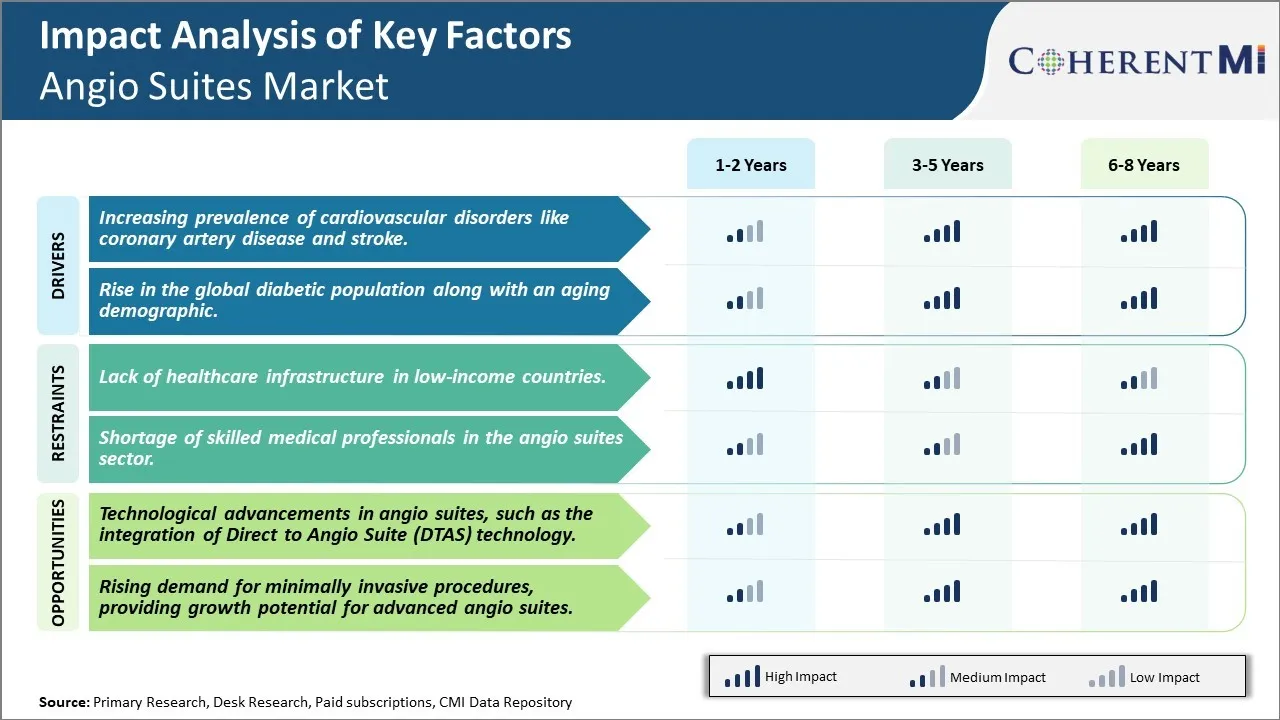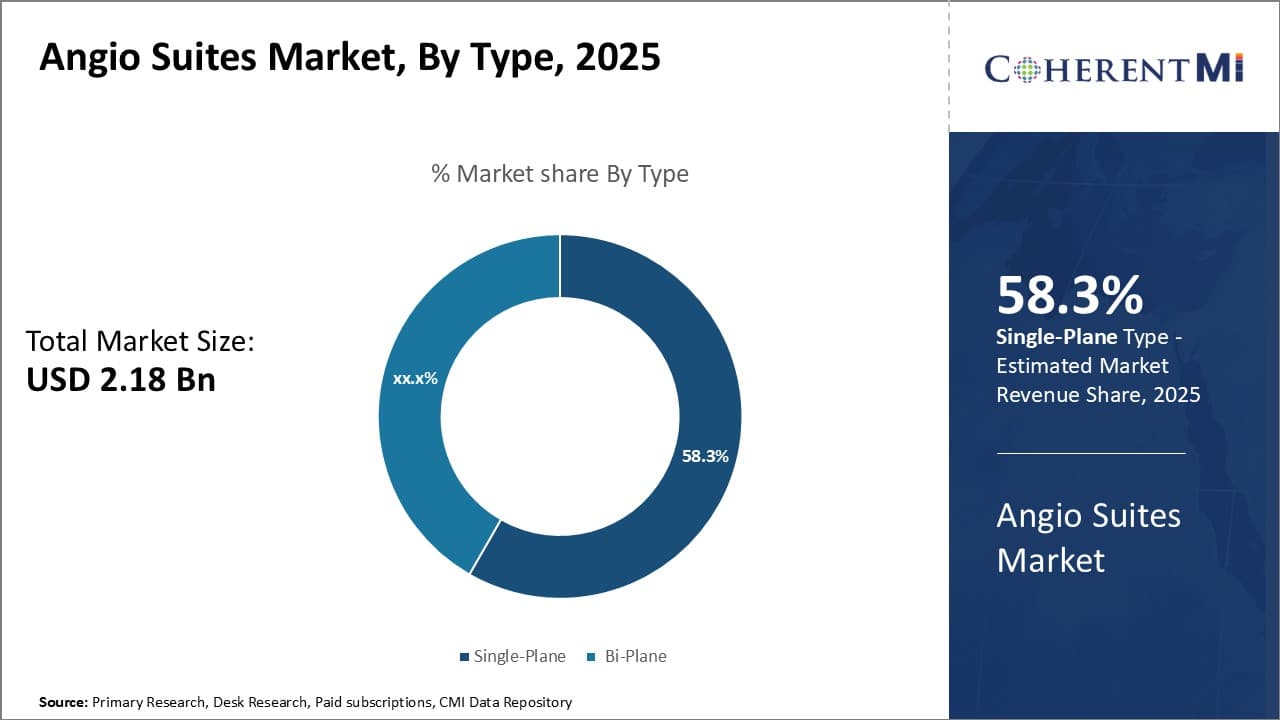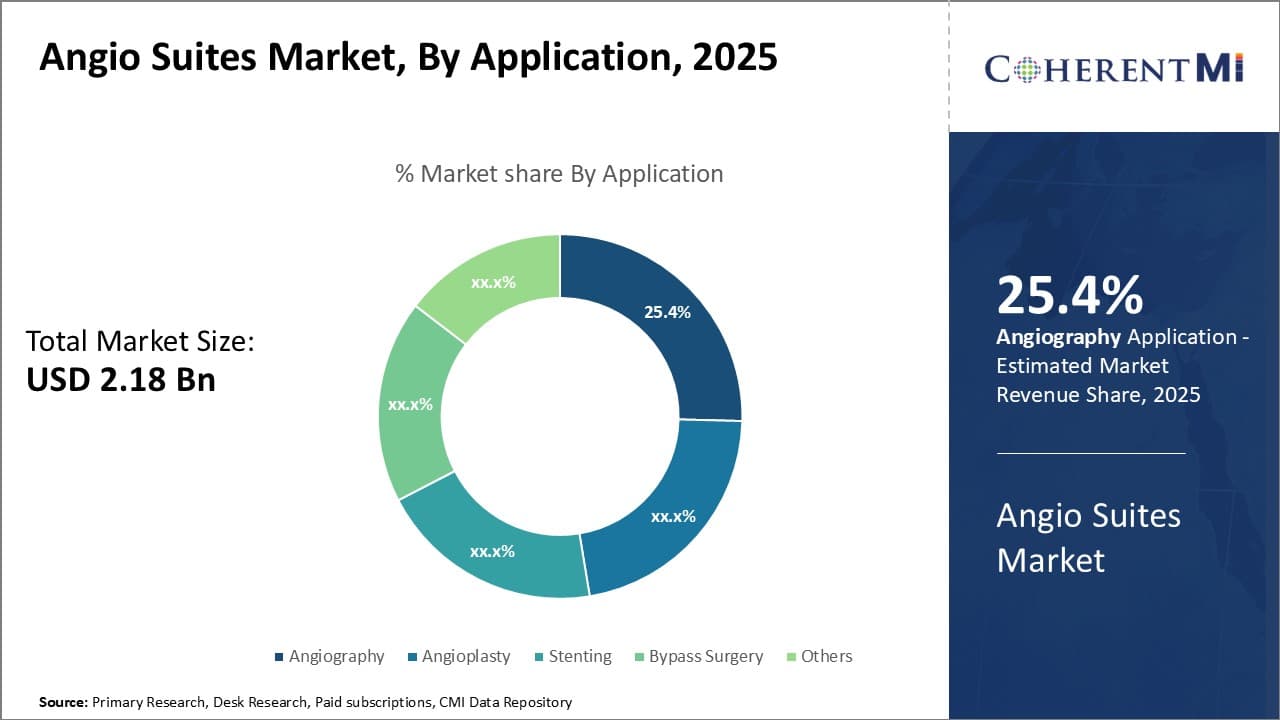

The angio suites market is estimated to be valued at USD 2.18 Bn in 2025 and is expected to reach USD 3.28 Bn by 2032, growing at a compound annual growth rate (CAGR) of 6.00% from 2025 to 2032. The increasing prevalence of cardiovascular diseases and rising demand for minimally invasive surgeries are expected to drive the growth of this market during the forecast period.
The market is witnessing positive trends with growing adoption of advanced imaging systems that help surgeons perform complex cardiovascular procedures. There is an increase in demand for state-of-the-art angio suites equipped with latest imaging technologies to enhance treatment outcomes. Manufacturers are investing in research and development to launch newer angio suite systems integrated with AI and augmented reality capabilities. This is expected to open up new opportunities for vendors in this space over the coming years.
Market Size in USD Bn
CAGR6.00%
| Study Period | 2025-2032 |
| Base Year of Estimation | 2024 |
| CAGR | 6.00% |
| Market Concentration | Medium |
| Major Players | Siemens, Koninklijke Philips N.V., Hitachi, Ltd., General Electric, Shimadzu Corporation and Among Others |
Market Driver - Increasing prevalence of cardiovascular disorders like coronary artery disease and stroke
The rising cases of cardiovascular diseases across the world has become a major concern for healthcare systems. Cardiovascular disorders like coronary artery disease and stroke have established themselves as one of the top causes of mortality. Coronary artery disease mainly occurs due to the buildup of plaque in the arteries that supply blood to the heart. Over time, this plaque hardens and narrows the coronary arteries, reducing blood flow. At times, the arteries may suddenly become completely blocked, causing a heart attack. Strokes occur when the blood supply to the brain gets disrupted leading to loss of brain functions.
A combination of factors like sedentary lifestyles, unhealthy diets, smoking, increasing stress levels, obesity and genetics have contributed to the increasing prevalence of these disorders. Recent studies reveal that coronary artery disease remains the single largest cause of death across both developed and developing nations. As per estimates by the World Health Organization, cardiovascular diseases account for over 17 million deaths globally each year. The figures are particularly alarming in developing economies where heart disease related fatalities are projected to rise significantly in the coming decades owing to rapid urbanization and changing risk factors. Many developing countries are also experiencing a shift towards younger age groups getting affected by these non-communicable diseases.
Given the threat posed by cardiovascular disorders on human health and lives, there is growing focus on improved diagnostics and treatment. Angiography procedures have emerged as a widely used and effective diagnostic method to evaluate the arteries of the heart or brain. Interventional techniques like angioplasty and stenting are commonly recommended for restoring blood flow if blockages are detected through angiography. The rising disease burden has led to greater utilization of specialized rooms called angiography suites across hospitals and clinics for performing such image-guided cardiovascular procedures. In many markets, hospitals are actively investing in advanced angiography equipment and upgrading existing facilities to handle the growing patient volumes seeking diagnosis and treatment. This growing emphasis on quality care for cardio-vascular illnesses through angiography is fueling the expansion of the angio suites market.
Market Driver - Rise in the global diabetic population along with an aging demographic
Diabetes has become one of the significant global health challenges of current times due to increasing prevalence. As per estimates by the International Diabetes Federation, around 537 million adults around the world were living with diabetes in 2021 and the figures are projected to rise to 783 million by 2045. Long-standing cases of diabetes significantly increase the risks of cardiovascular diseases like coronary artery disease and strokes through various pathways. Elderly people have a higher probability of developing type 2 diabetes and also tend to harbor the disease for longer periods without control. This makes them more vulnerable to associated macrovascular complications.
At the same time, improvements in healthcare have enabled people to lead longer lives across the world. A rapidly growing chunk of the global population now falls in the category of the elderly and very elderly. An aging demographic presents unique healthcare needs and challenges. Older age further exacerbates the risks from diabetes and complicates its management. Most health systems lack infrastructure as well as specialists to handle the unique needs of geriatric patients. As a result, senior citizens are at an even greater risk of heart diseases compared to the general population.
In light of the growing threat from diabetes and aging populations in various regions, there is increased emphasis on timely diagnosis and effective management of diabetes-induced cardiovascular complications. Hospitals and clinics are conducting aggressive screening programs to identify high-risk individuals. Any anomalies detected through non-invasive tests are thoroughly evaluated through angiography. Growing need for such specialized cardiac examinations and minor procedures among diabetic and elderly patients is driving demand for well-equipped angiography facilities and modern angio suites. Several hospital networks are adopting proactive strategies to upgrade their infrastructure with angiography labs to address the unique healthcare needs of this demographic vulnerable to heart disorders.
 To learn more about this report, Download Free Sample Copy
To learn more about this report, Download Free Sample Copy
Market Challenge - Lack of healthcare infrastructure in low-income countries
The angio suites market faces significant challenges in low-income countries due to lack of proper healthcare infrastructure. Most low-income nations struggle to develop basic healthcare facilities due to resource constraints. Setting up well-equipped angio suites requires large investments in medical equipment, training of specialists and establishing dedicated procedure rooms. This puts such advanced diagnostic and interventional capabilities out of reach for many countries with inadequate funding for the healthcare sector. Even if funds can be mobilized to procure angio suites, maintaining them and ensuring continuous supply of consumables is a huge task without supporting infrastructure. This gap is further accentuated in rural areas which do not have access to even primary care facilities. Unless healthcare infrastructure is strengthened in parallel, introducing high-end angio suites alone will have limited impact in terms of access and adoption in underdeveloped regions. Tackling the root causes of lack of infrastructure needs coordinated efforts from governments as well as global health organizations to assist low-income nations.
Market Opportunity - Technological advancements in angio suites, such as the integration of Direct to Angio Suite (DTAS) technology
The angio suites market is poised to benefit tremendously from ongoing technological advancements. One such promising innovation is the integration of Direct to Angio Suite (DTAS) technology that allows angiograms and other interventional imaging to be performed directly in the angio suite without needing backup storage systems or secondary review workstations. DTAS solutions enable top quality images and live guidance for interventional procedures using dedicated hardware and software. This improves workflow efficiency within busy cath labs and cardiovascular imaging centers. DTAS technology also enhances collaboration as angiographic images can be viewed real-time by multiple physicians from any location for timely decision making. Being a disruptive technology, DTAS solutions are likely to transform angio suite design and functionality in the future. Leading OEMs are already introducing DTAS-enabled angio suites with advanced flat panel detectors and specialized consoles. This reflects the vast scope of technological upgrades in angio suites to deliver optimized patient outcomes.
Continuous innovation and enhancement of existing angiography suites has been a core strategy for market leaders like Siemens Healthineers, GE Healthcare and Philips. For example, in 2020, Siemens launched the Artis icono biplane system with advanced imaging technologies like needle-selective imaging. This suite allows physicians to precisely image a small area around a needle or catheter instead of the whole anatomy, resulting in better image quality and lower radiation dose. Such innovative new systems have helped Siemens gain market share.
Acquiring smaller angio suite manufacturers has been a strategy to expand product portfolio and geographical presence. In 2016, GE Healthcare acquired Vascular Insights to strengthen its vascular imaging business. This expanded GE's portfolio of specialty devices to enhance angio suites. Similarly, Philips acquired Volcano Corporation in 2015 to integrate physiology into its angiography platform. Such acquisitions strengthened their product offerings and competitive positioning in the market.
Major players have proactively focused on high growth emerging markets like India, Brazil, China through effective local partnerships and price optimization strategies. For example, Siemens partnered with local players in China and tailored its product offerings to meet unique needs within budget constraints prevalent in these regions. This helped Siemens gain a dominant 25% market share in China by 2019.
Market leaders prioritized understanding specific clinical needs to develop tailored solutions. For example, based on physician feedback, Philips developed Azurion with functionalities like single-button imaging to simplify complex procedures. Similarly, GE collaborated with hospitals to optimize C-arm positioning workflows. Such customer-centric approaches helped build strong brand loyalty and preference.
 To learn more about this report, Download Free Sample Copy
Insights, By Type: Single-plane dominates due to its simplicity and cost-effectiveness
To learn more about this report, Download Free Sample Copy
Insights, By Type: Single-plane dominates due to its simplicity and cost-effectiveness
Within the angio suites market segmented by type, single-plane sub-segment contribute the largest share of 58.3% owing to their simplicity and affordability. As the name suggests, single-plane systems utilize just one x-ray emitter and detector, allowing for straightforward two-dimensional imaging of vessels and cavities. Their single-plane design makes the equipment intrinsically less complex compared to bi-plane systems with dual emitters and detectors. This translates to lower production costs and procurement prices for single-plane angio suites.
The streamlined design of single-plane systems also means fewer intensive staff training requirements and simpler maintenance needs. Clinics and hospitals appreciate the reduced technical overhead associated with Single-Plane suites. Their ease of use has helped drive broader adoption rates compared to more specialized bi-plane suites. Lower total cost of ownership is a key factor driving hospital budget approvals for Single-Plane purchases.
Portability is another advantage, as single-plane designs can be more compactly built. This facilitates flexible intra-facility mobility and transfers between operating theaters. Their size has also enabled integration into tighter improvised spaces during emergencies or in mobile surgical units. The inherent transportability of single-plane suites supports their popularity in community settings and for offering angiography in remote or underserved areas.
 To learn more about this report, Download Free Sample Copy
To learn more about this report, Download Free Sample Copy
Insights, By Application: Angiography is the cornerstone imaging procedure
Within the application segments of the angio suites market, angiography sub-segment contributes the highest share of 25.4%. Angiography involves minimally invasive imaging of vessels through injection of a contrast agent, allowing physicians to evaluate blood flow, diagnose issues, and guide interventional procedures. It serves as the essential pre-procedure evaluation and intra-procedure imaging tool.
The non-invasive nature and diagnostic capabilities of angiography have established it as the standard first-line imaging approach for numerous cardiovascular and neurological conditions. Its ability to precisely map vessel anatomy without incision is less risky than alternative inspection methods. Angiography is also readily combined with minimally invasive treatments during the same session, such as angioplasty, stenting, or embolization.
The versatility and visibility angiography provides have made it integral to managing a broad range of diseases. These include coronary artery disease, peripheral artery disease, cerebrovascular conditions, tumors, and traumatic injuries. Rising global incidence of such afflictions correspondingly increases the clinical need for angiography services. It constitutes a high-volume core application sustaining regular angio suite utilization.
New angiography techniques also continue broadening its clinical role. Angiography suites are being enhanced with 3D reconstructive capabilities, low-dose radiation protocols, automated positioning, and lesion-specific imaging to better address evolving disease landscapes. These application segment-level refinements help shield angiography from substitution by competing modalities.
The angio suites market is set to grow due to a combination of rising cases of cardiovascular diseases, particularly in high-income countries, and the rapid advancement in medical technology. As the global population ages and the incidence of diabetes increases, the demand for sophisticated diagnostic and treatment options like angio suites is expected to soar. Moreover, the market is witnessing significant technological advancements, such as the integration of real-time imaging and robotic precision in angio suites, which are improving outcomes for patients and increasing the appeal of these systems to healthcare providers.
The major players operating in the angio suites market include Siemens, Koninklijke Philips N.V., Hitachi, Ltd., General Electric, Shimadzu Corporation, Canon Inc., FUJIFILM Holdings Corporation, Hologic, Inc., Planmeca, Mindray Medical International Limited, ZEISS International, Guerbet, Surgical Science and B. Braun.
Would you like to explore the option of buying individual sections of this report?
Vipul Patil is a dynamic management consultant with 6 years of dedicated experience in the pharmaceutical industry. Known for his analytical acumen and strategic insight, Vipul has successfully partnered with pharmaceutical companies to enhance operational efficiency, cross broader expansion, and navigate the complexities of distribution in markets with high revenue potential.
Angio Suites Market is segmented By Type (Single-Plane, Bi-Plane), By Application (Angiography, Angi...
Angio Suites Market
How big is the Angio Suites Market?
The Angio Suites Market is estimated to be valued at USD 2.18 in 2025 and is expected to reach USD 3.28 Billion by 2032.
What are the major factors driving the angio suites market growth?
The increasing prevalence of cardiovascular disorders like coronary artery disease and stroke and rise in the global diabetic population along with an aging demographic are the major factors driving the angio suites market.
Which is the leading type in the angio suites market?
The leading type segment is single-plane.
Which are the major players operating in the angio suites market?
Siemens, Koninklijke Philips N.V., Hitachi, Ltd., General Electric, Shimadzu Corporation, Canon Inc., FUJIFILM Holdings Corporation, Hologic, Inc., Planmeca, Mindray Medical International Limited, ZEISS International, Guerbet, Surgical Science, and B. Braun are the major players.
What will be the CAGR of the angio suites market?
The CAGR of the angio suites market is projected to be 6.00% from 2025-2032.